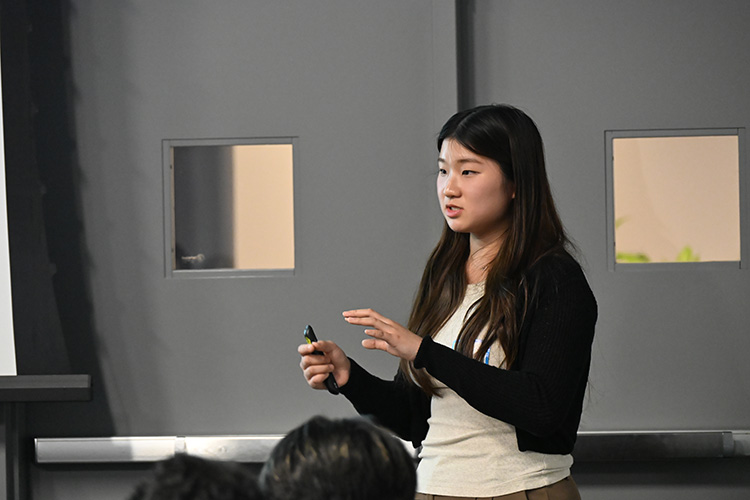September 3, 2025
Undergraduate Lian wins AIAA Region VI award for spectroscopic analysis of erosion on the ZaP-HD device.
Elyse Lian presenting to the 2025 AIAA Region VI Conference
A&A undergraduate researcher Elyse Lian has developed an experimental method to tackle one of the biggest challenges standing between us and clean fusion energy: measuring how plasma devices gradually erode themselves from the inside out. Her diagnostic system tracks the real-time erosion of fusion device surfaces — a critical step toward making both sustainable fusion power on Earth and deep space propulsion a reality. This research earned her 3rd place in the 2025 AIAA Region VI undergraduate category for her paper and presentation on "Spectroscopic Analysis of Erosion Rate from Electrode Surfaces on the ZaP-HD Device."
The challenge: Keeping plasma devices intact
Plasma devices, like the ZaP-HD device in our Flow Z-Pinch Lab, heat up to temperatures approximating the core of the sun. The plasma, at this intense heat and energy, gradually eats away at the device's components. It's like sandblasting at the atomic level. Energetic ions from the plasma bombard the interior surface of the device, breaking off atoms in a process called sputtering. The removal of these atoms changes the geometry of the device and degrades the purity of the plasma. The process ultimately wears the device down and diminishes the performance of the plasma.
Lian says, “Imagine your spacecraft is running on fusion propulsion for a deep-space mission. How would you replace the damaged parts? This erosion problem is a challenge we need to get right.”
A first step is measuring the erosion
Professor Uri Shumlak, Lian’s faculty adviser, spells out the importance of Lian’s work. “We know that this erosion of the interior walls of fusion devices happens, but we don’t quite yet know the scale. What Elyse has done with her experimental set-up is measure the erosion in real time. This will help us learn more about why it is happening, and then, ultimately, how to mitigate it.”
Lian developed a way to measure the erosion precisely as it happens. Working with the ZaP-HD device's graphite nosecone — the part that takes the biggest beating from the plasma — she created a diagnostic system using an ICCD spectrometer and photomultiplier tube.
When the graphite atoms knocked off from the nosecone fall into the plasma, the plasma’s heat excites their electrons. They jump to higher energy levels, but eventually they settle down again, which releases light as the energy lowers. Her system uses the ionization per photon method, which measures the intensity of light emission and connects it to the actual rate of material loss. While her preliminary results show peak erosion rates that may be higher than expected, this gives researchers exactly what they need: real numbers to work with as they advance the method and develop better materials and protective techniques.
Measurement method moves us closer to sustainable fusion energy
Lian's research isn't just about understanding the problem — it's about solving it. In fusion systems, even tiny amounts of eroded material can crash performance by stealing energy that should be going toward fusion reactions. In space propulsion, erosion can mean the difference between a successful deep-space mission and a stranded spacecraft millions of miles from home.
Her diagnostic method is already opening new possibilities. Researchers can now test different materials, experiment with protective coatings, or adjust operating conditions — all while watching exactly how these changes affect erosion rates.
Her recognition by the AIAA reflects both her technical innovation and the real-world impact of research happening right here at the University of Washington — research that's helping build the energy and exploration technologies of tomorrow.
